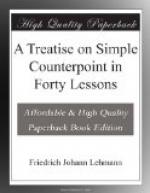[Illustration: Fig. 143.]
EXERCISES
To cantus firmus a write the fourth species in one part, as usual.
To cantus firmus b write first, second and fourth species in the other three parts. [Fig. 143_a_.]
To cantus firmus c write the first, third and fourth species in the other three parts. [Fig. 143_b_.]
To cantus firmus c write fourth species mixed in the other parts. [Fig. 143_c_.]
CANTI FIRMI
[Illustration: Fig. 144.]
LESSON XXIX
[Illustration: Fig. 145.]
EXERCISES
To canti firmi a and b write fifth species in one part, as before.
CANTI FIRMI
[Illustration: Fig. 146.]
LESSON XXX
[Illustration: Fig. 147.]
EXERCISES
To the cantus firmus write the fifth species in two parts. Write four times, changing the cantus firmus into every part. [Fig. 147_a_.]
Write one eight-measure phrase mixing the second, third and fourth species (b). Also write one exercise combining the first, second, third and fourth species (c).
CANTUS FIRMUS
[Illustration: Fig. 148.]
LESSON XXXI
[Illustration: Fig. 149.]
EXERCISES
To the cantus firmus write the fifth species in all of the other parts. [Fig. 149_a_.]
Write four eight-measure phrases with the fifth species in all parts. [Fig. 149_b_.]
CANTUS FIRMUS
[Illustration: Fig. 150.]
LESSON XXXII
[Illustration: Fig. 151.]
EXERCISES
Write six eight-measure phrases, using the fifth species in all the parts. Let the parts begin one after the other in imitation. [Fig. 151.]
LESSON XXXIII
FLORID MELODIES AS CANTI FIRMI FREE HARMONIZATION IN TWO-PART COUNTERPOINT
[Illustration: Fig. 152.]
Thus far, all notes in the measure foreign to the harmony on the first beat were treated as dissonances. Now, the cantus firmus may be harmonized at pleasure, the only restriction being that any tone foreign to the chord with which it enters must be treated as a dissonance. [Fig. 152.]
It is not necessary that each part be strictly florid, but that the effect of the parts as a whole should be so. This applies from this point to the end of these lessons.




